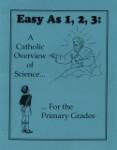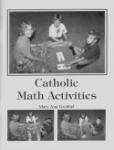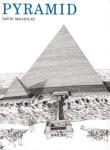Elementary
Easy As 1, 2, 3
This program provides families who like to use living books with a Catholic framework from which to study science. It is not a textbook but rather is 40 pages, of which approximately half are outlines, that are three hole punched and ready to go into your notebook. The parent that uses this will find the eleven units of science outlined very handy for creating their own program and clearly laid out so that they can tuck personal notes and activities into their notebook using the 40 pages as their point of organizing.
Catholic Math Activities
If you're looking for a way to liven up your math program or to bring in some painless math review you have to pick up this book. Catholic Math Activities provides dozens of math games that children actually enjoy playing and almost all of them only require dice and simple home-made material. The author makes use of children's interests by revolving the games around things such as baseball cards and animals. What really pleased me about this program is the clever way our Catholic faith was brought into these games.
The Cure of Ars
The Cure of Ars
Bernadette: Princess of Lourdes
Pyramid
Black and white illustrations and readable text take you through the building of a fictional pyramid in Ancient Egypt (but so close to reality that you'll hardly know the difference) from the beginning plans of a Pharaoh for his final resting place, thorugh years of construction, and finally, the Pharaoh's death, mummification and entombment. Fortunately, the emphasis is on the design and construction of the pyramid rather than mummification. The many detailed pictures illustrate tools, techniques, materials used, etc. This is a very nice book and comes highly recommended.
Catholic National Readers: New Primer and Book One
I found this volume very useful for early reading practice with my first-grade daughter. We were able to move into this after she finished the Bob Books. The advantage I saw to this particular primer in contrast with the later series (Cardinal or Faith and Freedom) was that it was much harder for her to guess the words because of either the pictures or the heavy repetition so common in other early readers. The passages are very short, although not particularly story like. Some of the phraseology was rather archaic, such as "Has a boy the jug? A boy has not the jug." (p.
Catholic National Readers: Book 3
This one contains stories like "St Elizabeth" and "Our Lady's Flower Society". This book contains dictation exercises with some of the lessons, as well as vocabulary, and comprehension.
Catholic National Readers: Book 5
This one contains stories like "The Power of the Blessed Sacrament" and "Rip Van Wynkle". It also contains pronunciation, dictation, vocabulary, and comprehension with the lessons.






